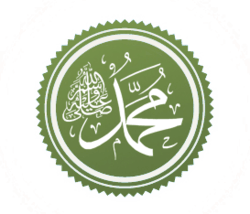Mus‘ab ibn 'Umair
Mus‘ab ibn Umair (Arabic: مصعب بن عمير) also known as Mus‘ab al-Khayr ("the Good")[1] was a sahabi (companion) of Muhammad. From the Banū ‘Abd al-Dār branch of the Quraysh, he embraced Islam in 614 CE and was the first ambassador of Islam.[2] He was Martyred in the Battle of Uhud in 625 CE.[3]
Mus'ab ibn Umair | |
|---|---|
 | |
| 1st Ambassador of Medina | |
| In office c. 620 – 621 CE | |
| Personal details | |
| Born | 8 January 594 Mecca |
| Died | 22 December 624 (aged 30) Uhud, Medina, Hejaz, Arabia |
| Cause of death | Martyrdom in the Battle of Uhud |
| Known for | Being a Sahaba of Muhammad |
| Part of a series on |
| Muhammad |
|---|
 |
|
Views |
|
Related |
|
Early life
Mus‘ab ibn Umair was born to the Banū 'Abd al-Dār branch of the Quraysh tribe.[4] his exact birth year is not known, it is believed that he was born sometime between 594 and 598 CE since he was very young when he embraced Islam in 614.[5] Mus‘ab was the son of Umair ibn Hashim and Khunaas Bint Maalik, and his parents were wealthy.[6] Even as a young man, he was permitted to attend meetings of the Quraysh elders.[6] He was one of the very handsome men in Makkah and Quraysh to an extent that some women used to be in a queue to just have atleast one glance at him when he used to walk by. He was also one of the Richest men in Makkah. Every cloth of his was stiched by a tailor, even his shoes were made by his cobbler in Yemen. Further more he used to smell good. The fragrance he used to have was very well known that the people would know that he is near before he had even appeared. After converting to Islam he became one of the beautiful reciters of Qur'an and was a wise man full of wisdom. He was capable of convincing any one with his speech. He is a role model for generations of muslim youth.
Conversion to Islam
The first Muslims used to meet with the Prophet Muhammad (s) at the house of Al-Arqam known as the Islamic Learning Center.[7] Mus'ab became interested and went to this house to find out more about Islam. As a result of hearing the reciting of the Noble Qur'an and the preaching of Muhammad (s), he converted.[8][9]
At first Mus'ab kept his faith a secret, for he was afraid of how his mother would react.[1] However, One day a Quraysh opponent of the Prophet Muhammad (s), Uthman ibn Talha, saw him entering Al Arqam's house and joining the Muslim prayers. The news spread and eventually reached his mother, who chained him in their house with the intention of making him recant.[10] Mus'ab was confident in his faith and would not renounce his faith. Muhammad (s) advised him to join the companions who were emigrating to Abyssinia so that he would not be harassed again.[8]
First Ambassador of Islam
Mus‘ab ibn Umayr was appointed the first ambassador of Islam and was sent to Yathrib (Medina)[2][11] to prepare the city for the forthcoming Hijra after the first pledge with the ansar. A man of Medina named Asad ibn Zurarah assisted him. After they had preached Islam, many residents of Medina were converted, including such leading men such as Sa'd ibn Mu'adh, Usayd ibn Hudayr and Sa'd ibn Ubadah.[12] The Medinan converts were known as Ansars ("helpers").[2]
Military campaigns
Battle of Badr
He participated in the Battle of Badr. Muhammad's forces included Ali, Hamza, Mus`ab ibn `Umair, Az-Zubair bin Al-'Awwam, Ammar ibn Yasir, and Abu Dharr al-Ghifari. The Muslims also brought seventy camels and two horses, meaning that they either had to walk or fit three to four men per camel.[13] However, many early Muslim sources indicate that no serious fighting was expected,[14] and the future Caliph Uthman stayed behind to care for his sick wife Ruqayyah, the daughter of Muhammad.[15] Salman the Persian also could not join the battle, as he was still not a free man.[16]
Many of the Quraishi nobles, including Amr ibn Hishām, Walid ibn Utba, Shaiba, and Umayah ibn Khalaf, joined the Meccan army. Their reasons varied: some were out to protect their financial interests in the caravan; others wanted to avenge Ibn al-Hadrami, the guard killed at Nakhlah; finally, a few must have wanted to take part in what was expected to be an easy victory against the Muslims.[17] Amr ibn Hishām is described as shaming at least one noble, Umayah ibn Khalaf, into joining the expedition. [18]
Death in the Battle of Uhud
In the Battle of Uhud in 624 CE, Muhammad (s) assigned Mus'ab ibn Umayr to carry the Muslim flag.[4] During the battle, some Muslims were under the impression that the war was over left their positions on the battlefield,[4] giving the opposing forces hope of attacking Muhammad (s) himself. On realizing the danger, Mus'ab, who was of a similar position and colouring to Muhammad (s), raised his flag and shouted the takbir ("Allah (God) is The Greatest!"), with the intention of diverting the enemies' attention towards himself and allowing Muhammad (s) to remain unhurt.[19] Mus'ab was attacked, and his right hand was severed holding the Flag, but he continued to repeat the words of the Noble Quran, and took the flag in his left hand. when his left hand was severed he took hold of it with his arms but never let the flag fall. "Muhammad is only a Messenger of God. Messengers have passed away before him.'(Qur'an,3:144)'"[6][20] Eventually Musab was hit by a spear thrown by Ibn Kami'ah[19] and died. But never let the flag fall while he had breath in his chest.[3]
Burial
Sixty-five Muslims were killed in the battle.[21] Khabbab ibn al-Aratt narrated:
We migrated in the company of Allah's Apostle, seeking Allah's Pleasure. So our reward became due and sure with Allah (swt). Some of us have been dead without enjoying anything of their rewards (here), and one of them was Mus'ab bin 'Umar who was martyred on the day of the battle of Uhud, and did not leave anything except a Namira (i.e. a sheet in which he was shrouded). If we covered his head with it, his feet became uncovered, and if we covered his feet with it, his head became visible. So the Prophet (s) said to us, "Cover his head with it and put some Idhkhir (i.e. a kind of grass) over his feet or place Idhkhir over his feet." But some amongst us have got the fruits of their labor ripened, and they are collecting them.[22][23]
Muhammad stood beside Musab's body and recited: "Among the believers are men who have been true to what they have pledged to God.[24] The Messenger of God testifies that you are martyrs in the sight of God." When Mus'ab's wife, Hammanah bint Jahsh, heard about the death of her brother and maternal uncle, she replied, "To Allah we belong and to him we will verily return. I ask Allah‘s forgiveness for him." But when she heard about the death of her husband Mus'ab, she shouted and cried.[11]
See also
- Sunni view of the Sahaba
- List of expeditions of Muhammad
References
- IslamKotob. Companions of the Prophet. Islamic Books. Retrieved 7 August 2012.
- UNESCO (2012). Different Aspects of Islamic Culture: Vol.3: The Spread of Islam Throughout the World Volume 3 of Different aspects of Islamic culture. UNESCO, 2012. p. 51–. ISBN 9789231041532. Retrieved 9 August 2012.
- Jean-Pierre Filiu, M. B. DeBevoise (2011). Apocalypse in Islam University of California Press. University of California Press, 2011. p. 186–. ISBN 9780520264311. Retrieved 11 August 2012.
- Muhammad Saed Abdul-Rahman (2009). The Meaning and Explanation of the Glorious Qur'an (Vol 2) 2nd Edition. MSA Publication Limited, 2009. p. 69–. ISBN 9781861796448. Retrieved 7 August 2012.
- Scott C. Lucas (2004). Constructive Critics, Ḥadīth Literature, and the Articulation of Sunnī Islam: The Legacy of the Generation of Ibn Sad, Ibn Maīn, and Ibn Ḥanbal. BRILL, 2004. p. 269–. ISBN 9789004133198. Retrieved 7 August 2012.
- Rafi Ahmad Fidai, N.M. Shaikh (2002). Companion of the Holy Prophet, the. Adam Publishers, 2002. p. 40,47–. ISBN 9788174352231. Retrieved 7 August 2012.
- Dr Ali Muhammad As Sallaabee (2005). The Noble Life of the Prophet (Vol1-3) Volume 1 of The Noble Life of the Prophet. Darussalam, 2005. p. 175–. ISBN 9789960967875. Retrieved 8 August 2012.
- "Biography of Musab ibn Umair" (pdf). techislam.com. Retrieved 2012-08-23.
- Scott C. Lucas (2004). Constructive Critics, Ḥadīth Literature, and the Articulation of Sunnī Islam: The Legacy of the Generation of Ibn Sad, Ibn Maīn, and Ibn Ḥanbal. BRILL, 2004. p. 269–. ISBN 9789004133198. Retrieved 8 August 2012.
- Ariel Merari (2010). Driven to Death: Psychological and Social Aspects of Suicide Terrorism. Oxford University Press, 2010. p. 96–. ISBN 9780195181029. Retrieved 7 August 2012.
- Safi ur Rahman Al Mubarakpuri (2002). Ar-Raheeq Al-Makhtūm. Darussalam, 2002. p. 187,338–. ISBN 9789960899558. Retrieved 7 August 2012.
- Muhammad Husayn Haykal, Islamic Book Trust (1994). The Life of Muḥammad. The Other Press, 1994. p. 186–. ISBN 9789839154177. Retrieved 7 August 2012.
- Lings, pp. 138–139
- "Sahih al-Bukhari: Volume 5, Book 59, Number 287". Usc.edu. Archived from the original on 16 August 2010. Retrieved 16 September 2010.
- "Sahih al-Bukhari: Volume 4, Book 53, Number 359". Usc.edu. Retrieved 16 September 2010.
- "Witness-pioneer.org". Witness-pioneer.org. 16 September 2002. Archived from the original on 5 February 2010. Retrieved 19 March 2010.
- Martin Lings, p. 139–140.
- "Sahih al-Bukhari: Volume 5, Book 59, Number 286". Usc.edu. Archived from the original on 16 August 2010. Retrieved 16 September 2010.
- Ali Unal (2007). The Qur'an with Annotated Interpretation in Modern English. Tughra Books, 2007. p. 160–. ISBN 9781597840002. Retrieved 7 August 2012.
- Quran 3:144
- Muhammad ibn Ishaq, Sirat Rasul Allah. Translated by Guillaume, A. (1955). The Life of Muhammad, pp. 401-403. Oxford: oxford University Press.
- Sahih al-Bukhari, 5:59:378
- Translated: Dr Muhammad Muhsin Khan (1994). Summarized Sahih Al Bukhari (Large). Darussalam, 1994. p. 323–. ISBN 9789960732206. Retrieved 7 August 2012.
- Quran 33:23